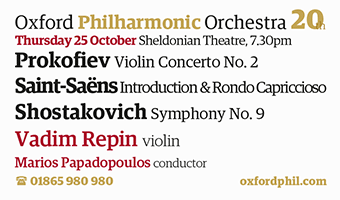Oxford Philharmonic's Thursday concert programme was predominantly Russian, from the twin giants of its 20th century music, and with a Saint-Saëns bon-bon thrown in as light relief in the middle. Vadim Repin had given a masterclass at the university's music faculty on the Monday, and now here he was for Prokofiev's Violin Concerto No. 2 in G minor before a pretty full midweek audience. The work was composed just after Prokofiev's return to settle in
The soloist opens the work on his own, preceded by no orchestral exposition. I believe this was something never done before in a violin concerto. This start consists of a brooding melody, a simple thing until soloist and orchestra settle down to a serious discussion of it. Repin had more scope to demonstrate his mastery in the Andante with its long, sustained melody over a simple accompaniment; this is really the abiding memory from this concerto. He brought out little oscillations fluttering though the solo part, first joined by the flute but then the shrill flutterings re-commence, exploiting the upper register of Repin's fiddle, an original Stradivari from 1733.
He cuts a tall, straight-backed figure, and even in the quasi-danse macabre of the third movement with its spiky harmony, he made little concession to virtuosity, although towards the end when accompanied by Julian Poole's bass drum marking the time with almost hypnotic effect (castanets had earlier performed something of the same function), tingling excitement was in the air. Applause was strong and greeted by Repin with quiet, notably dignified bows.
I suppose there's a tenuous link between Prokofiev's 2nd Violin Concerto and the Saint-Saens Introduction and Rondo Capriccioso in that the former had just come to live in Paris when the latter, a lifelong Parisian, died there in 1921. There's a Spanish swagger to the piece, as if the patio tables of a café on a hot summer evening in
There was no encore, though the audience's very prolonged applause was clearly calling for one. In fact Repin was zooming off to the airport for a plane home to
After the interval came Shostakovich's Symphony No. 9, not one of the most-frequently heard of his 15 symphonies, and almost the shortest of them. Cultural Commissar Zakharov said of this work and its two predecessors: 'Who [considers them works of genius] other than the foreign bandits and imperialists?'. Conductor Marios Papadopoulos appeared unmoved by this complaint, directing a jaunty start, but generally adopting quite a measured tempo, rightly allowing the textures of the different strings sections to be heard. Soon the piccolo of Daniel Shao (an ex-Oxford student) was heard, and he managed his extensive part in the work with notably pure tone and a bit of panache. He was matched later by the bassoon of Oliver Galletta who had a prolonged solo in the 'largo', a marvellous passage where the bassoon is rudely interrupted by horns and trombones before, unflustered, resuming its course. Before this in the 'presto' we'd heard a brave trumpet fanfare, all parade-ground and square-bashing, one of the surprisingly few indications that the work dates from 1945, begun two months after VE Day.
Towards the end of the finale there occurs one of those moments that are pure Shostakovich: dramatic strings and a trumpet fanfare presaging a hard, driving rhythm; perhaps a black ZiL limousine or a troika, thrusting full-tilt along a snow-packed highway, bearing Comrade Dmitri Dmitriyevich Shostakovich to yet another fateful interview with Comrade Stalin.




